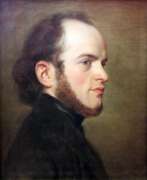History painting Biedermeier


Johann Peter Krafft was a German and Austrian painter of the mid-nineteenth century. He is known as a painter and graphic artist who specialized in genre, battle, portraiture and history painting. Krafft is believed to have had a significant influence on Austrian painting and was a leading portraitist of the Neoclassical style in Vienna. He later influenced the development of genre painting during the Viennese Biedermeier period.
Krafft co-founded the Vienna Artists' Union and was elected to the council of the Vienna Academy of Art in 1835. The artist also acted as a consultant for the protection of cultural monuments at Karlstein Castle in Bohemia.


Gustav Kraus, also known as Gustav Friedrich or Gustav Wilhelm, was a Bavarian painter and lithographer.
He studied at the Munich Academy of Fine Arts and was admitted as a member of the Munich Art Society, and is considered a representative of the Biedermeier. In 1836 he founded his own lithographic publishing house. In his landscape works, Kraus combined topographical precision with artistic quality.
His urban and architectural vedute, depictions of historical events, including maneuvers, parades, processions, inauguration ceremonies, portraits of noble contemporaries, sketches of costumes and uniforms were published by many publishing houses. One of the most valuable of Kraus's works today is the depiction of the Oktoberfest procession of 1835 with 24 colorful lithographs.


Franz Ringer is a German painter, graphic designer and sculptor.
Franz Ringer came from an old Munich family of carpenters. At the age of 20 he traveled to Tyrol and Switzerland, enrolled at the Technical University of Aachen, returned to Munich and worked as an assistant to the sculptor Josef von Kramer (1841-1908) for ten years, which shaped him as a master stylistically and technically.
Ringer was one of the best-known decorative arts artists in Munich at the time, and he artistically designed many restaurants in Bavaria and in Munich. His design projects are extremely varied.
Franz Ringer is also known as the creator of stone and glass beer mugs, which he painted in Art Nouveau, Art Deco or Biedermeier style. The first Ringer mugs to go into production were made by Villeroy & Boch in 1905. These mugs quickly became popular with the public, especially at scheduled conferences and festivals. Ringer worked for many ceramic manufacturers in Germany. In addition to Villeroy & Boch, these included Reinhold Merkelbach, Merkelbach & Wick, Marzi & Remi, Albert Jakob Thewalt and others.


Julius Schoppe was a German painter of the mid-nineteenth century. He is known as a painter and graphic artist, famous for his portraits during the Biedermeier era.
Julius Schoppe studied Italian art in Rome and copied works by Raphael, Titian and Correggio. His copies of Raphael's paintings were included in the collection of the King of Prussia and were exhibited in Sans Souci. The master was also the author of landscapes, historical and genre paintings, as well as an original series of "living paintings" that were admired for their grace and painterly authenticity. He was a professor at the Berlin Academy of Fine Arts.


Adolph Friedrich Erdmann von Menzel was a German Realist artist noted for drawings, etchings, and paintings. Along with Caspar David Friedrich, he is considered one of the two most prominent German painters of the 19th century, and was the most successful artist of his era in Germany. First known as Adolph Menzel, he was knighted in 1898 and changed his name to Adolph von Menzel.
His popularity in his native country, owing especially to his history paintings, was such that few of his major paintings left Germany, as many were quickly acquired by museums in Berlin. Menzel's graphic work (and especially his drawings) were more widely disseminated; these, along with informal paintings not initially intended for display, have largely accounted for his posthumous reputation.











